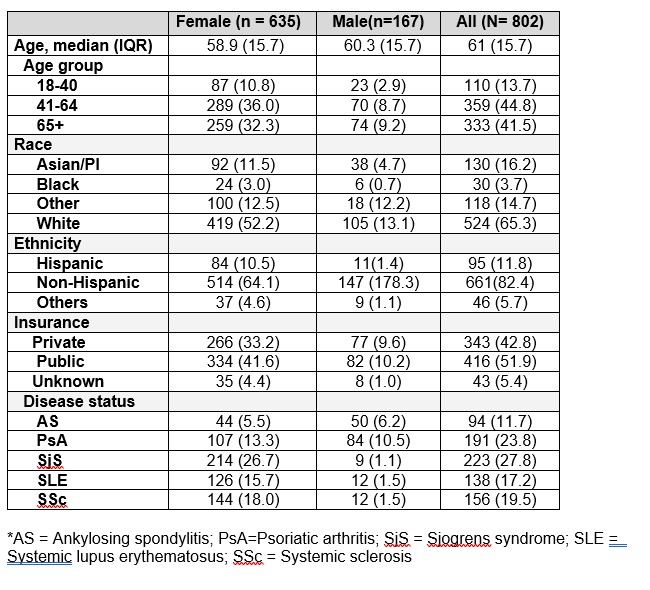Session Information
Session Type: Poster Session A
Session Time: 10:30AM-12:30PM
Background/Purpose: To create greater precision in case definitions for chronic pain in EHRs, we recently identified 15 different case definitions for chronic pain using structured data elements from the EHR, comprised of unique combinations of structured data elements including pain scores, diagnostic codes, analgesic medications, and pain interventions among patients with autoimmune rheumatic diseases. While clinic notes are considered the gold standard for phenotyping, there is limited research on how well structured data elements align with these notes across diverse groups defined by subgroups (e.g., sex, race/ethnicity, age). By exploring these discrepancies, the study seeks to identify potential biases and improve the accuracy and equity of phenotyping algorithms, ultimately enhancing personalized patient care and reducing healthcare disparities.
Methods: We conducted chart reviews of 802 patients with ≥1 of the 15 case definitions for chronic pain during outpatient rheumatology clinic visits in 2019 at a large tertiary healthcare system (Table 1). For each record, chronic pain was definitive if one of the following criteria was met: (i) Any indication in the clinic notes by the treating clinician describing the complaint of pain as chronic, OR (ii) ≥2 encounters, separated by ≥3 months, where the same or similar pain complaint was noted as present and continuous. Next, we calculated the percent agreement of chronic pain between clinic notes and phenotyping algorithms. The numerators comprised patients identified with chronic pain in the clinic notes, and the denominator comprised patients with each phenotype. This calculation was repeated for each subgroup of sex, race, ethnicity, age, insurance status, and disease status.
Results: We found heterogeneity in the agreement between chart reviews and phenotyping algorithms. Women (61-89%) consistently had higher percent agreement compared with men (45-78%) (Figure 1). We also found that Asians (52-73%) consistently had the lowest percent agreement compared with White patients (57-87%). Older adults (age 65+ years) had the lowest percent agreement (51-78%) compared with adults ares 41-64 years (59-94%). Publicly (57-80%) insured patients had lower percent agreement compared with the privately insured (57-97%). Patients with Sjogrens (79-95%) had the highest percent agreement and while patients with systemic sclerosis (44-83%) had the lowest.
Conclusion: This study highlights clinically relevant heterogeneity in the concordance between clinic notes and phenotyping algorithms for chronic pain across various demographic groups. The observed discrepancies, particularly among women, Asian patients, older adults, disease status and those with different insurance statuses, underscore the need for tailored approaches to improve the accuracy of structured data in electronic health records. By addressing these disparities, we can enhance the precision of phenotyping algorithms, ultimately leading to more equitable and personalized patient care in rheumatology.
To cite this abstract in AMA style:
Begum T, Veeranki B, Chike O, Falasinnu T. The Problem of Pain in Rheumatology: Sociodemographic and Disease-related Correlates of Agreement Between Structured Data Elements and Clinical Notes in Chronic Pain Documentation Practices in EHR [abstract]. Arthritis Rheumatol. 2024; 76 (suppl 9). https://acrabstracts.org/abstract/the-problem-of-pain-in-rheumatology-sociodemographic-and-disease-related-correlates-of-agreement-between-structured-data-elements-and-clinical-notes-in-chronic-pain-documentation-practices-in-ehr/. Accessed .« Back to ACR Convergence 2024
ACR Meeting Abstracts - https://acrabstracts.org/abstract/the-problem-of-pain-in-rheumatology-sociodemographic-and-disease-related-correlates-of-agreement-between-structured-data-elements-and-clinical-notes-in-chronic-pain-documentation-practices-in-ehr/


